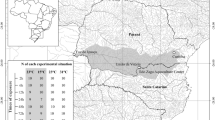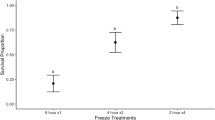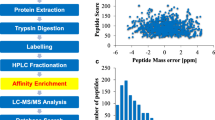Abstract
Levels of ubiquitin (Ub)-conjugated proteins, as an index of misfolded or damaged proteins, were measured in notothenioid fishes, with both Antarctic (Trematomus bernacchii, T. pennellii, Pagothenia borchgrevinki) and non-Antarctic (Notothenia angustata, Bovichtus variegatus) distributions, as well as non-notothenioid fish from the Antarctic (Lycodichthys dearborni, Family Zoarcidae) and New Zealand (Bellapiscis medius, Family Tripterygiidae), in an effort to better understand the effect that inhabiting a sub-zero environment has on maintaining the integrity of the cellular protein pool. Overall, levels of Ub-conjugated proteins in cold-adapted Antarctic fishes were significantly higher than New Zealand fishes in gill, liver, heart and spleen tissues suggesting that life at sub-zero temperatures impacts protein homeostasis. The highest tissue levels of ubiquitinated proteins were found in the spleen of all fish. Ub conjugate levels in the New Zealand N. angustata, more closely resembled levels measured in other Antarctic fishes than levels measured in other New Zealand species, likely reflecting their recent shared ancestry with Antarctic notothenioids.



Similar content being viewed by others
References
Ananthan J, Goldberg AL, Voellmy R (1986) Abnormal proteins serve as eukaryotic stress signals and trigger the activation of the heat-shock genes. Science 232:522–524
Anderson JB (1999) Antarctic marine geology. Cambridge University Press, Cambridge
Basu N, Todgham AE, Ackerman PA, Bibeau MR, Nakano K, Schulte PM, Iwama GK (2002) Heat shock protein genes and their functional significance in fish. Gene 295:173–183
Bradford M (1976) A rapid and sensitive method for the quantitation of microgram quantities of protein utilizing the principle of protein dye-binding. Anal Biochem 72:248–254
Buckley BA, Place SP, Hofmann GE (2004) Regulation of heat shock genes in isolated hepatocytes from an Antarctic fish, Trematomus bernacchii. J Exp Biol 207:3649–3656
Cheng C-HC, Chen L, Near TJ, Jin Y (2003) Functional antifreeze glycoprotein genes in temperate-water New Zealand nototheniid fish infer an Antarctic evolutionary origin. Mol Biol Evol 20:1897–1908
Cheng C-HC, Cziko PA, Evans CW (2006) Nonhepatic origin of notothenioid antifreeze reveals pancreatic synthesis as common mechanism in polar fish freezing avoidance. Proc Natl Acad Sci USA 103:10491–10496
Clarke A, Johnston IA (1996) Evolution and adaptive radiation of Antarctic fishes. Trends Ecol Evol 11:212–218
Coppes Petricorena ZL, Somero GN (2007) Biochemical adaptations of notothenioid fishes: comparisons between cold temperate South American and New Zealand species and Antarctic species. Comp Biochem Physiol A 147:799–807
Crockett EL, Sidell BD (1990) Some pathways of energy metabolism are cold adapted in Antarctic fishes. Physiol Zool 63:472–488
D’Amico S, Marx J-C, Gerday C, Feller G (2003) Activity-stability relationships in extremophilic enzymes. J Biol Chem 278:7891–7896
D’Avino R, di Prisco G (1997) The hemoglobin system of Antarctic and non-Antarctic notothenioid fishes. Comp Biochem Physiol A 118:1045–1049
DeVries AL (1983) Antifreeze peptides and glycopeptides in cold-water fishes. Annu Rev Physiol 45:245–260
Dobbs GH, DeVries AL (1975) Renal function in Antarctic teleost fishes: serum and urine composition. Mar Biol 29:59–70
Eastman JT (1993) Antarctic fish biology-evolution in a unique environment. Academic, San Diego
Egginton S (1996) Blood rheology of Antarctic fishes: viscosity adaptations at very low temperatures. J Fish Biol 48:513–521
Fänge R, Nilsson S (1985) The fish spleen: structure and function. Experientia 41:152–158
Fields PA, Somero GN (1998) Hot spots in cold adaptation: localized increases in conformational flexibility in lactate dehydrogenase A(4) orthologs of Antarctic notothenioid fishes. Proc Natl Acad Sci USA 95:11476–11481
Fletcher GL, Hew CL, Davies PL (2001) Antifreeze proteins of teleost fishes. Annu Rev Physiol 63:359–390
Fraser KPP, Clarke A, Peck LS (2002) Low-temperature protein metabolism: seasonal changes in protein synthesis and RNA dynamics in the Antarctic limpet Nacella concinna Strebel 1908. J Exp Biol 205:3077–3086
Fujita J (1999) Cold shock response in mammalian cells. J Mol Microbiol Biotechnol 1:243–255
Glickman MH, Ciechanover A (2002) The ubiquitin-proteasome proteolytic pathway: destruction for the sake of construction. Physiol Rev 82:373–428
Goldberg AL (2003) Protein degradation and protection against misfolded or damaged proteins. Nature 426:895–899
Hardewig I, Van Dijk PLM, Moyes CD, Pörtner HO (1999) Temperature-dependent expression of cytochrome-c oxidase in Antarctic and temperate fish. Am J Physiol 277:R508–R516
Hartl FU, Hayer-Hartl M (2002) Molecular chaperones in the cytosol: from nascent chain to folded protein. Science 295:1852–1858
Hightower LE (1991) Heat shock, stress proteins and proteotoxicity. Cell 66:191–197
Hochachka PW, Somero GN (2002) Biochemical adaptation. Mechanism and process in physiological evolution. Oxford University Press, New York
Hofmann GE, Somero GN (1995) Evidence for protein damage at environmental temperatures: seasonal changes in levels of ubiquitin conjugates and hsp70 in the intertidal mussel, Mytilus trossulus. J Exp Biol 198:1509–1518
Hofmann GE, Buckley BA, Airaksinen S, Keen J, Somero GN (2000) The Antarctic fish Trematomus bernacchii lacks heat-inducible heat shock protein synthesis. J Exp Biol 203:2331–2339
Hoyoux A, Blaise V, Collins T, D’Amico S, Gratia E, Huston AL, Marx J-C, Sonan G, Zeng Y, Feller G, Gerday C (2004) Extreme catalysts from low-temperature environments. J Biosci Bioeng 98:317–330
Iwama GK, Thomas PT, Forsyth RB, Vijayan MM (1998) Heat shock protein expression in fish. Rev Fish Biol Fish 8:35–56
Jaenicke R (1990) Protein structure and function at low temperature. Philos Trans R Soc Lond B Biol Sci 326:535–553
Johnston IA (2003) Muscle metabolism and growth in Antarctic fishes (suborder Notothenioidei): evolution in a cold environment. Comp Biochem Physiol B 136:701–713
Johnston IA, Calvo J, Guderley H, Fernandez D, Palmer L (1998) Latitudinal variation in the abundance and oxidative capacities of muscle mitochondria in perciform fishes. J Exp Biol 210:1–12
Kawall HG, Torres JJ, Sidell BD, Somero GN (2002) Metabolic cold adaptation in Antarctic fishes: evidence from enzymatic activities of the brain. Mar Biol 140:279–286
Lindquist S (1986) The heat shock response. Annu Rev Biochem 55:1151–1191
Marsh AG, Maxson RE, Manahan DT (2001) High macromolecular synthesis with low metabolic cost in Antarctic sea urchin embryos. Science 291:1950–1952
Marx J-C, Collins T, D’Amico S, Feller G, Gerday C (2007) Cold-adapted enzymes from marine Antarctic microorganisms. Mar Biotech 9:293–304
O’Grady SM, DeVries AL (1982) Osmotic and ionic regulation in polar fishes. J Exp Mar Biol Ecol 57:219–228
Place SP, Hofmann GE (2005) Constitutive expression of a stress-inducible heat shock protein gene, hsp70, in phylogenetically distant Antarctic fish. Polar Biol 28:261–267
Place SP, Zippay ML, Hofmann GE (2004) Constitutive roles for inducible genes: evidence for the alteration in expression of the inducible hsp70 gene in Antarctic notothenioid fishes. Am J Physiol 287:R429–R436
Pörtner HO (2006) Climate-dependent evolution of Antarctic ectotherms: an integrative analysis. Deep Sea Res II 53:1071–1104
Rinehart JP, Hayward SAL, Elnitsky MA, Sandro LH, Lee RE, Denlinger DL (2006) Continuous up-regulation of heat shock proteins in larvae, but not adults, of a polar insect. Proc Natl Acad Sci USA 103:14223–14227
Robertson RF, el Haj AJ, Clarke A, Taylor EW (2001) The effects of temperature on metabolic rate and protein synthesis following a meal in the isopod Glyptonotus antarcticus Eights (1852). Polar Biol 24:677–686
Schubert U, Anton LC, Gibbs J, Norbury CC, Yewdell JW, Bennink JR (2000) Rapid degradation of a large fraction of newly synthesized proteins by proteasomes. Nature 404:770–774
Sherman M, Goldberg AL (2001) Cellular defenses against unfolded proteins: a cell biologist thinks about neurodegenerative diseases. Neuron 29:15–32
Siddiqui KS, Cavicchioli R (2006) Cold-adapted enzymes. Annu Rev Biochem 75:403–433
Smith MAK, Haschemeyer AEV (1980) Protein metabolism and cold adaptation in Antarctic fishes. Physiol Zool 53:373–382
Somero GN (1995) Proteins and temperature. Annu Rev Physiol 57:43–68
Storch D, Pörtner HO (2003) The protein synthesis machinery operates at the same expense in eurythermal and cold stenothermal pectinids. Physiol Biochem Zool 76:28–40
Storch D, Heilmayer O, Hardewig I, Pörtner HO (2003) In vitro protein synthesis capacities in a cold stenothermal and a temperate eurythermal pectinid. J Comp Physiol B 173:611–620
Storch D, Lannig G, Pörtner HO (2005) Temperature-dependent protein synthesis capacities in Antarctic and temperate (North Sea) fish (Zoarcidae). J Exp Biol 208:2409–2420
van Breukelen F, Carey HV (2002) Ubiquitin conjugate dynamics in the gut and liver of hibernating ground squirrels. J Comp Physiol B 172:269–273
Velickovska V, Lloyd BP, Qureshi S, vanBreukelen F (2005) Proteolysis is depressed during torpor in hibernators at the level of the 20S core protease. J Comp Physiol B 175:329–335
Wells RMG, Ashby MD, Duncan SJ, MacDonald JA (1980) Comparative study of the erythrocytes and haemoglobins in notothenioid fishes from Antarctica. J Fish Biol 17:517–527
Whiteley NM, Taylor EW, el Haj AJ (1996) A comparison of the metabolic cost of protein synthesis in stenothermal and eurythermal isopod crustaceans. Am J Physiol 271:R1295–R1303
Wickner S, Maurizi MR, Gottesman S (1999) Posttranslational quality control: folding, refolding and degrading proteins. Science 286:1888–1893
Wing SS, Haas AL, Goldberg AL (1995) Increase in ubiquitin-protein conjugates concomitant with the increase in proteolysis in rat skeletal muscle during starvation and atrophy denervation. Biochem J 307:639–645
Acknowledgements
We are indebted to many individuals who assisted us during the course of this project. In particular, we thank the field team members of Bravo 134 (Dr. B. Buckley, T. Crombie, J. Dutton, C. Osovitz and M. Zippay) for logistical support in obtaining Antarctic specimens. We further thank the United States Antarctic Program and Raytheon Polar Services Corporation for logistical and field support at McMurdo Station, Antarctica. We thank the University of Otago (Dunedin, New Zealand) for access to research facilities at Portobello Marine Laboratory (PML). In particular, we gratefully acknowledge the staff of PML, especially Bev Dickson (Lab Manager), Karen Bonney and Rene van Baalen for assistance in the collection of N. angustata and logistical support at PML. Finally, we thank Dr. Nann Fangue and Julia Uberuaga for their help in the collection of B. variegatus. This research was supported by National Science Foundation grant ANT-0440799 to G.E.H. and by a Natural Sciences and Engineering Research Council of Canada Postdoctoral Fellowship to A.E.T. This research was conducted in accordance with U.S. Federal animal welfare laws via approval and oversight by the University of California, Santa Barbara Institutional Animal Care and Use Committee (IACUC) (Protocol No. 634). Specimens were collected in compliance with the U.S. regulations governing collection of Antarctic organisms, the Antarctic Conservation Act of 1978 (Public Law 95-541) and the Antarctic Marine Living Resources Convention Act of 1984 (Public Law 98-623) and complied with the current laws of New Zealand.
Author information
Authors and Affiliations
Corresponding author
Additional information
Communicated by H.V. Carey.
Rights and permissions
About this article
Cite this article
Todgham, A.E., Hoaglund, E.A. & Hofmann, G.E. Is cold the new hot? Elevated ubiquitin-conjugated protein levels in tissues of Antarctic fish as evidence for cold-denaturation of proteins in vivo. J Comp Physiol B 177, 857–866 (2007). https://doi.org/10.1007/s00360-007-0183-2
Received:
Revised:
Accepted:
Published:
Issue Date:
DOI: https://doi.org/10.1007/s00360-007-0183-2




